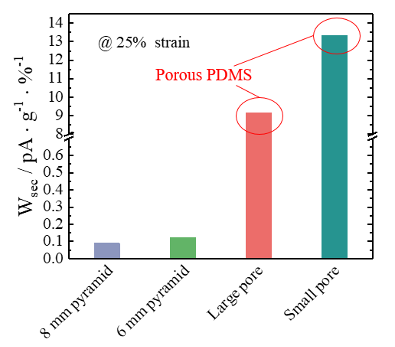Recently, Associate Professor Shao Lihua’s Group from the Institute of Solid Mechanics, Beihang University published an article titled “Ultrahigh flexoelectric effect of 3D interconnected porous polymers: modelling and verification” in Journal of the Mechanics and Physics of Solids, a well-known international journal of solid mechanics, which reported the latest research findings on the flexoelectric effect of porous materials.
Electromechanical coupling is an important effect of the mutual conversion between mechanical energy and electric energy. Among them, flexoelectric effect has demonstrated its broad applications in structural health monitoring, new strain gradient sensors, new piezoelectric/flexoelectric composite materials, new acceleration sensors, etc., as it has small size effect and is free from the limitation of material symmetry and Curie temperature. Due to the positive correlation between the flexoelectric effect and the strain gradient, existing studies mainly focus on the flexoelectric effect of macroscopic solid materials under irregular shape or special load. However, the flexoelectric output of solid materials is usually very low, and improving the flexoelectric output of materials is a challenging subject that has received wide attention.
Inspired by the small-size effect of flexoelectricity, the research group led by Shao Lihua analyzed the flexoelectricity of three-dimensional interconnected porous materials. For the first time, they suggested and proved that porous materials have considerable flexoelectric output under the macroscopic uniform compression and bending load, established a porous material flexoelectricity model, and systematically revealed the porous flexoelectric output geometry dependence, providing important basis and guidance for porous material flexoelectricity effect as well as its structural design and optimization. According to the reviewers of the paper, this research is of clear theoretical structure and was carried out under neat experiment.

Fig. 1. Schematic illustration of the deformation of a porous material and the induced flexoelectricity

Fig. 2. Wsecof the porous PDMS specimens is two orders of magnitude higher than that of the truncated pyramids

Fig. 3. A bending sensor of the thin porous PDMS film: (a) sensing the knuckle bending movement, (b) the flexoelectric output at different bending angles and modes
Associate Professor Shao Lihua is the only corresponding author of this paper. She is one of the selected candidates of the “Outstanding Hundred Talent” program of Beihang university. Her research interests include micro and nano mechanics, composite material mechanics, and properties and applications of new functional materials. The co-first authors of the paper are Zhang Mingyuan and Yan Dongze, postgraduate students from the School of Aeronautics Science and Engineering, and the co-author of the paper is Professor Wang Jianxiang from Peking University. The research was supported by the National Natural Science Foundation of China.
The link to the article is:
http://www.sciencedirect.com/science/article/pii/S0022509621000818?dgcid=author
Reported by Zhou Jianbang
Reviewed by Lin Guiping
Edited by Jia Aiping
Translated by Wen Peiyu

